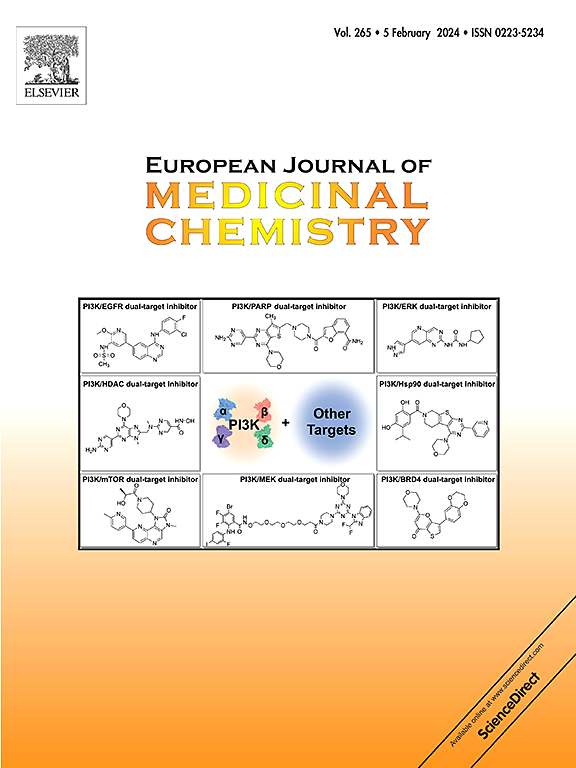1,2,4-Oxadiazoles in medicinal chemistry: trends of the last years
IF 6
2区 医学
Q1 CHEMISTRY, MEDICINAL
引用次数: 0
Abstract
1,2,4-Oxadiazoles have emerged as a significant class of heterocyclic compounds in medicinal chemistry due to their diverse biological activities and versatile applications in drug discovery. Herein is reported an in-depth analysis of the structural properties, synthetic methodologies, and pharmacological significance of 1,2,4-oxadiazoles. The compound's unique five-membered ring containing three heteroatoms offers remarkable stability and tunable physicochemical properties, making it an attractive scaffold for the development of novel therapeutic agents, as confirmed by already approved drugs.
The review highlights the broad spectrum of biological activities associated with 1,2,4-oxadiazoles, including antimicrobial, anti-inflammatory, anticancer, antiviral, and central nervous system related activities. These diverse effects underscore the scaffold's potential for targeting multiple disease pathways. Several studies demonstrate that structural modifications on the oxadiazole ring can significantly influence its pharmacokinetic and pharmacodynamic profiles, enabling the design of selective and potent drug candidates.
Additionally, it has explored recent advances in synthetic strategies for constructing the 1,2,4-oxadiazole core, such as cyclization reactions involving amidoximes, nitrile oxides, and other precursors. Modern approaches using transition-metal catalysis, microwave-assisted synthesis, and green chemistry techniques are also discussed, emphasizing their importance in improving efficiency and scalability for pharmaceutical applications.
Furthermore, the role of 1,2,4-oxadiazole as bioisostere replacement for esters and amides is highlighted, particularly in enhancing metabolic stability and modulating target selectivity. Application of computational methods, including molecular docking and QSAR modeling, have been also covered in understanding ligand-receptor interactions and guiding lead optimization.
This review underscores the growing prominence of 1,2,4-oxadiazoles in modern drug design and their potential to address unmet medical needs. With continued research and innovation, these scaffolds are poised to play a pivotal role in the next generation of therapeutic agents across multiple disease areas.


1,2,4-恶二唑在药物化学中的应用
1,2,4-恶二唑因其多样的生物活性和在药物发现中的广泛应用而成为一类重要的杂环化合物。本文对1,2,4-恶二唑的结构性质、合成方法和药理意义进行了深入分析。该化合物独特的五元环含有三个杂原子,提供了卓越的稳定性和可调的物理化学性质,使其成为开发新型治疗药物的有吸引力的支架,已经批准的药物证实了这一点。该综述强调了与1,2,4-恶二唑相关的广泛生物活性,包括抗菌、抗炎、抗癌、抗病毒和与中枢神经系统相关的活性。这些不同的作用强调了支架靶向多种疾病途径的潜力。一些研究表明,对恶二唑环的结构修饰可以显著影响其药代动力学和药效学特征,从而可以设计出选择性和强效的候选药物。此外,它还探讨了构建1,2,4-恶二唑核的合成策略的最新进展,例如涉及氨基肟,腈氧化物和其他前体的环化反应。本文还讨论了利用过渡金属催化、微波辅助合成和绿色化学技术的现代方法,强调了它们在提高制药应用效率和可扩展性方面的重要性。此外,1,2,4-恶二唑作为酯类和酰胺类生物同位异构体替代品的作用也得到了强调,特别是在增强代谢稳定性和调节靶标选择性方面。计算方法的应用,包括分子对接和QSAR建模,也涵盖了理解配体-受体相互作用和指导导联优化。这篇综述强调了1,2,4-恶二唑在现代药物设计中的重要性,以及它们在解决未满足的医疗需求方面的潜力。随着不断的研究和创新,这些支架有望在跨多种疾病领域的下一代治疗剂中发挥关键作用。
本文章由计算机程序翻译,如有差异,请以英文原文为准。
求助全文
约1分钟内获得全文
求助全文
来源期刊
CiteScore
11.70
自引率
9.00%
发文量
863
审稿时长
29 days
期刊介绍:
The European Journal of Medicinal Chemistry is a global journal that publishes studies on all aspects of medicinal chemistry. It provides a medium for publication of original papers and also welcomes critical review papers.
A typical paper would report on the organic synthesis, characterization and pharmacological evaluation of compounds. Other topics of interest are drug design, QSAR, molecular modeling, drug-receptor interactions, molecular aspects of drug metabolism, prodrug synthesis and drug targeting. The journal expects manuscripts to present the rational for a study, provide insight into the design of compounds or understanding of mechanism, or clarify the targets.

 求助内容:
求助内容: 应助结果提醒方式:
应助结果提醒方式:


